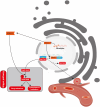Exploring the potential of VGLL3 methylation as a prognostic indicator for intracranial aneurysm with gender-specific considerations
- PMID: 38348744
- PMCID: PMC10912501
- DOI: 10.1042/BSR20231374
Exploring the potential of VGLL3 methylation as a prognostic indicator for intracranial aneurysm with gender-specific considerations
Abstract
DNA methylation is widely recognized to play a role in intracranial aneurysm (IA) pathogenesis. We investigated the levels of methylation of vestigial-like 3 (VGLL3) in IA and explored its potential as a prognostic indicator. A total of 48 patients with IA and 48 healthy controls were included in the present study. Methylation levels of CpG sites were assessed using bisulfite pyrosequencing, and levels of VGLL3, TEAD, and YAP in the blood were measured by real-time quantitative polymerase chain reaction testing. VGLL3 methylation was significantly higher in controls than in IA patients (P=0.001), and this phenomenon was more pronounced in females (P<0.001). Compared with the control group, the expression levels of VGLL3 and TEAD in the blood of IA patients were significantly increased, while YAP was significantly decreased. VGLL3 methylation was positively correlated with HDL (P=0.003) and female Lpa concentration (r = 0.426, P=0.03), and was also negatively correlated with age (P=0.003), APOE (P=0.005), and VGLL3 mRNA expression (P<0.001). Methylation and mRNA expression of VGLL3 may serve as indicators of IA risk in females (AUC = 0.810 and 0.809). VGLL3 methylation may participate in the pathogenesis of IA by regulating the expression of the VGLL3/TEAD/YAP pathway, and its gene methylation and expression levels have IA risk prediction value.
Keywords: CpG island; DNA Methylation; intracranial aneurysm; vestigial-like 3.
© 2024 The Author(s).
Conflict of interest statement
The authors declare that the research was conducted in the absence of any commercial or financial relationships that could be construed as a potential conflict of interest.
Figures





Similar articles
-
DNA methylation of the MAP3K10 gene may participate in the development of intracranial aneurysm.Gene. 2023 Jan 30;851:147024. doi: 10.1016/j.gene.2022.147024. Epub 2022 Oct 29. Gene. 2023. PMID: 36341729
-
Vestigial-like family member 3 (VGLL3), a cofactor for TEAD transcription factors, promotes cancer cell proliferation by activating the Hippo pathway.J Biol Chem. 2020 Jun 26;295(26):8798-8807. doi: 10.1074/jbc.RA120.012781. Epub 2020 May 8. J Biol Chem. 2020. PMID: 32385107 Free PMC article.
-
DNA methylation and mRNA expression of glutathione S-transferase alpha 4 are associated with intracranial aneurysms in a gender-dependent manner.Front Genet. 2023 Jan 9;13:1079455. doi: 10.3389/fgene.2022.1079455. eCollection 2022. Front Genet. 2023. PMID: 36699470 Free PMC article.
-
Tobacco Smoking Increases Methylation of Polypyrimidine Tract Binding Protein 1 Promoter in Intracranial Aneurysms.Front Aging Neurosci. 2021 Jul 6;13:688179. doi: 10.3389/fnagi.2021.688179. eCollection 2021. Front Aging Neurosci. 2021. PMID: 34295240 Free PMC article.
-
DNA Methylation of Patatin-Like Phospholipase Domain-Containing Protein 6 Gene Contributes to the Risk of Intracranial Aneurysm in Males.Front Aging Neurosci. 2022 Jul 11;14:885680. doi: 10.3389/fnagi.2022.885680. eCollection 2022. Front Aging Neurosci. 2022. PMID: 35898327 Free PMC article.
Cited by
-
The immunometabolic function of VGLL3 and female-biased autoimmunity.Immunometabolism (Cobham). 2024 May 8;6(2):e00041. doi: 10.1097/IN9.0000000000000041. eCollection 2024 Apr. Immunometabolism (Cobham). 2024. PMID: 38726338 Free PMC article. Review.
References
-
- Aoki T., Kataoka H., Ishibashi R., Nozaki K., Morishita R. and Hashimoto N. (2009) Reduced collagen biosynthesis is the hallmark of cerebral aneurysm: contribution of interleukin-1beta and nuclear factor-kappaB. Arterioscler. Thromb. Vasc. Biol. 29, 1080–1086 10.1161/ATVBAHA.108.180760 - DOI - PubMed
-
- Etminan N., Chang H.S., Hackenberg K., de Rooij N.K., Vergouwen M.D.I., Rinkel G.J.E.et al. . (2019) Worldwide incidence of aneurysmal subarachnoid hemorrhage according to region, time period, blood pressure, and smoking prevalence in the population: a systematic review and meta-analysis. JAMA Neurol. 76, 588–597 10.1001/jamaneurol.2019.0006 - DOI - PMC - PubMed
-
- Connolly E.S. Jr, Rabinstein A.A., Carhuapoma J.R., Derdeyn C.P., Dion J., Higashida R.T.et al. . (2012) Guidelines for the management of aneurysmal subarachnoid hemorrhage: a guideline for healthcare professionals from the American Heart Association/american Stroke Association. Stroke 43, 1711–1737 10.1161/STR.0b013e3182587839 - DOI - PubMed
Publication types
MeSH terms
Substances
Grants and funding
LinkOut - more resources
Full Text Sources
Medical
Molecular Biology Databases
Miscellaneous

